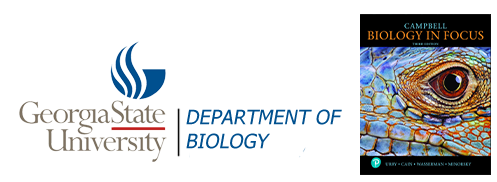- Home
Welcome !
Welcome to john houghton's home page for his biology courses. This site is designed as a hub for curating and sharing lectures, course syllabi, assignments, and links to relevant resources. Use the menu bar at the top of the screen to navigate through the site.
(Please note: this page is currently under construction.)

- BIOL 2107
Fall '23 CRN86772
Lectures: (1)
- Courses
BIOL 2107 Principles of Biology I
- Resources
General Resources
The Following
are examples of questions that may be asked in the upcoming quiz 2 and / or Test 2.
Section 1
1. In pea plants, the allele for tall stalks (T) is dominant over the allele for short stalks (t). Suppose a cross between a tall pea plant and a short pea plant produces 43 tall offspring and 47 short offspring. If one of these tall offspring is then crossed with a short stalk offspring, what ratio of genotypes would be most likely in their offspring?
a 1 Tt : 3 tt
b All are Tt
c. 3 Tt : 1 tt
d. 1 TT : 2 Tt : tt
e. 1 Tt : 1 tt
2. If one parent's blood-type is type A and the other's is blood-type B, which of the following blood-type options could their offspring have??
a. A
b. B
c. O
d. AB
e. All of the above
3. In the ABO blood group system in humans, if a person of type-B blood has children with a person of type-AB blood, what potential blood types could their children possess?
a Type A, Type B, Type AB
b Type B, Type AB
c. Type A, Type B, Type O
d. Type O, Type B, Type AB
e. Type A & Type B
4. A gene in corn has two alleles, one for yellow kernels and one for dark brown kernels. Cross pollination of yellow corn (pure bred) and brown corn (assume pure bred) results in ears of corn that have an approximately even mix of brown spotted yellow kernels. GIven what we have discussed in lecture... which term below best describes the relationship between the two alleles?
a. Homologous traits
b. Chimeric variants
c. Codominat traits
d. incomplete dominant traits
e. wild-type and mutant
5. As you know, in labrador retrievers, the allele for a black coloured coat (B) is dominant to the allele for brown fur coat colour (b). However, if a lab has two copies of the "recessive allele" for a "pigment-depositing gene" (e), it can only have yellow coloured fur. In a cross of two doubly heterozygous black labs (BbEe x BbEe), what fraction of the next generation would one expect to be yellow? - Hint we did this in lecture 13, so check out the lecture's pdf.
a. 1/4
b. 1/8
c. 1/16
d. 3/16
e. 3/8
6. (a) Given that, in barley plants, the allele for tall stalks is dominant over short stalks and the allele for wide leaves is dominant over thin leaves. assuming "independent assortment" what would be the best way to determine the genotype of a barley plant with a tall stalk and wide leaves?
a. Undertake a "Test cross" between a Tall stalk and thin leafed barley plant against itself.
b. Undertake a "Test cross" between a Tall stalk and Wide leafed Barley plant with a short stalk and
wide leafed barley plant.
c. Self cross a Tall stalk and Wide leafed barley plant
d. Undertake a "Test cross" between a Tall stalk and Wide leafed barley plant against a short stalk and
thin leafed barley plant.
e. Retake BIOL2107
7. In a cross of AaBb x AaBb, what fraction of the offspring can be expected to express EITHER ONE of the two dominant alleles, but NOT BOTH? Yes, you may have to draw out the Punnet square... the first time!
a. 9/16
b. 1/2.
c. 3/8.
d. 3/16.
e. 1/4.
8. If two genes demonstrate "independent assortment", which assumption is most likely true?
a. Crossing over between the genes does not occur
b. The two genes are located in very close proximity to each other on the same chromosome
c. The two genesa are located on the X chromosome
d. The two genes are located on different chromosomes or are far enoough away from each other on
the same chromosome as to always crossover.
e. The expresssion of one gene has NO effect on the expression of the other
9. The X-linked, recessive trait of colour-blindness is present in approximately 5% of males. If a mother (who is a carrier) and a father (who is unaffected) plan to have a child, what would the probability be that the child will be colour-blind?
a. 50 %
b. <5 %
c. 25%
d. 100 %
e. 0 %
Section 1B.
In the next several questions each question is worth 3 pts
Please “clearly” indicate your evaluation of the statement given.
If you believe the statement to be “False” then explain why you think so in the space provided.
11. In Prophase I of MEIOSIS chromosomes condense and "homologous chromsomes pair off and are able to recombine
A. TRUE B. FALSE
_______________________________________________________________________________
12. Mendel's 1st Law is the law of independent assortment
A. TRUE B. FALSE
_______________________________________________________________________________
13. The environment RARELY IF EVER plays a role in determining the GENOTYPE for a given trait
A. TRUE B. FALSE
_______________________________________________________________________________
About Contact GSU Academics Degrees & Majors |
Admissions Undergraduate Research Dept. of Biology |
Libraries University Library Campus Life Housing |
Athletics Alumni
|

|


